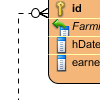Personalize Database Connection Settings to Aid in Team Development
When a development team is developing a system that requires accessing a database, it is a common practice to setup local databases on each of the development environment and populate them with all the required schema of the system so that developers can develop and test the function they implement with test data in their own database, rather than working with actual data with production database.

 In relational database, records are identified by a unique value. We call this value the primary key. Some databases allow to control how this unique value is being generated by defining the sequence. In this article, we will show you how to model the sequence with
In relational database, records are identified by a unique value. We call this value the primary key. Some databases allow to control how this unique value is being generated by defining the sequence. In this article, we will show you how to model the sequence with  The
The 